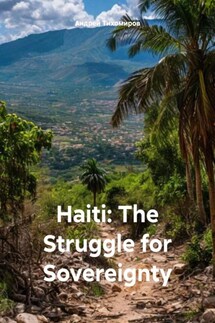General information about Haiti
Haiti, officially the Republic of Haiti, is a country on the island of Hispaniola in the Caribbean Sea, east of Cuba and Jamaica, and south of the Bahamas. It occupies three-eighths of the western part of the island, which it shares with the Dominican Republic. Haiti is the third largest country in the Caribbean, and with an estimated population of 11.4 million, is the most populous country in the Caribbean. The capital and largest city is Port-au-Prince.
The island was originally inhabited by the Taino people. The first Europeans arrived here in December 1492 during the first voyage of Christopher Columbus, founding the first European settlement in America, La Navidad, on the territory of the modern northeast coast of Haiti. The island was part of the Spanish Empire until 1697, when the western part was ceded to France and subsequently renamed San Domingo. French colonists established sugar plantations, where slaves brought from Africa worked. At the height of the French Revolution, enslaved people, Maroons and free people of color began the Haitian Revolution (1791-1804) led by former slave and general of the French army Toussaint Louverture. Napoleon's troops were defeated by Toussaint Louverture's successor, Jean-Jacques Dessalines (later Emperor Jacques I), who proclaimed the sovereignty of Haiti on January 1, 1804, which led to the massacre of the French. Haiti became the first independent State in the Caribbean, the second republic in the Americas, the first country in the Americas to officially abolish slavery, and the only country in history founded as a result of a slave revolt. This is how the first revolution in Latin America ended, which became "one of the largest events in the liberation struggle of peoples, in which the Haitian people wrote such a glorious page" (Slezkin L. Y. The revolution of Negro slaves on the island of San Domingo (Haiti) in 1791-1803.– Scientific notes on modern and modern history. Moscow 1956, issue 2, p. 206). The first century of independence was characterized by political instability, international isolation, unsustainable debt payments to France and a costly war with the neighboring Dominican Republic. Political instability and foreign economic influence caused the occupation of the United States from 1915 to 1934. A series of unstable presidencies was followed by almost three decades of dictatorship under the Duvalier family (1957-1986), which led to state-sanctioned violence, corruption and economic stagnation.
After the coup in 2004, the United Nations intervened to stabilize the situation in the country. In 2010, Haiti suffered a catastrophic earthquake, followed by a deadly outbreak of cholera. Due to the deteriorating economic situation, the country has experienced a socio-economic and political crisis marked by riots and protests, widespread famine and increased gang activity. As of May 2024, Haiti has no elected government officials left and has been described as a failed state.
Haiti is a founding member of the United Nations, the Organization of American States (OAS), the Association of Caribbean States, and the International Organization of la Francophonie. In addition to CARICOM, it is a member of the International Monetary Fund, the World Trade Organization, and the Community of Latin American and Caribbean States. Historically poor and politically unstable, Haiti has the lowest human development index in the Americas.
From the history of Haiti
Haiti comes from the indigenous Taino language and means "country of high mountains"; it was the original name for the entire island of Hispaniola ("Spanish Island" from Spanish isla española). The name was restored by Haitian revolutionary Jean-Jacques Dessalines as the official name of the independent San Domingo, as a tribute to the predecessors of the Indians.
The island of Haiti, three-eighths of which is occupied by Haiti, was settled about 6,000 years ago by Native Americans who are believed to have arrived from Central or Northern South America. It is believed that these people, who lived in the Paleolithic era, were mainly hunter-gatherers. In the 1st millennium BC, the ancestors of the Taino people, who spoke the Arawak language, began to migrate to the Caribbean Sea. Unlike the archaic peoples, they were engaged in intensive pottery production and agriculture. The earliest evidence of the existence of the ancestors of the Taino people in Hispaniola is the Ostionoid culture, which dates back to about 600 AD.
In the Taino society, the largest cell of the political organization was led by a cacique, or leader, as they were understood by Europeans. At the time of contact with Europe, the island of Hispaniola was divided between five "caciques": Magua in the northeast, Marien in the northwest, Jaragua in the southwest, Maguana in the central regions of Cibao and Higuey in the southeast.
Artifacts of the Taino culture include rock carvings in several places in the country. They have become national symbols of Haiti and tourist attractions. Modern Leogan, which originated as a French colonial city in the southwest, is located next to the former capital of Caciquedoma Xaragua.














